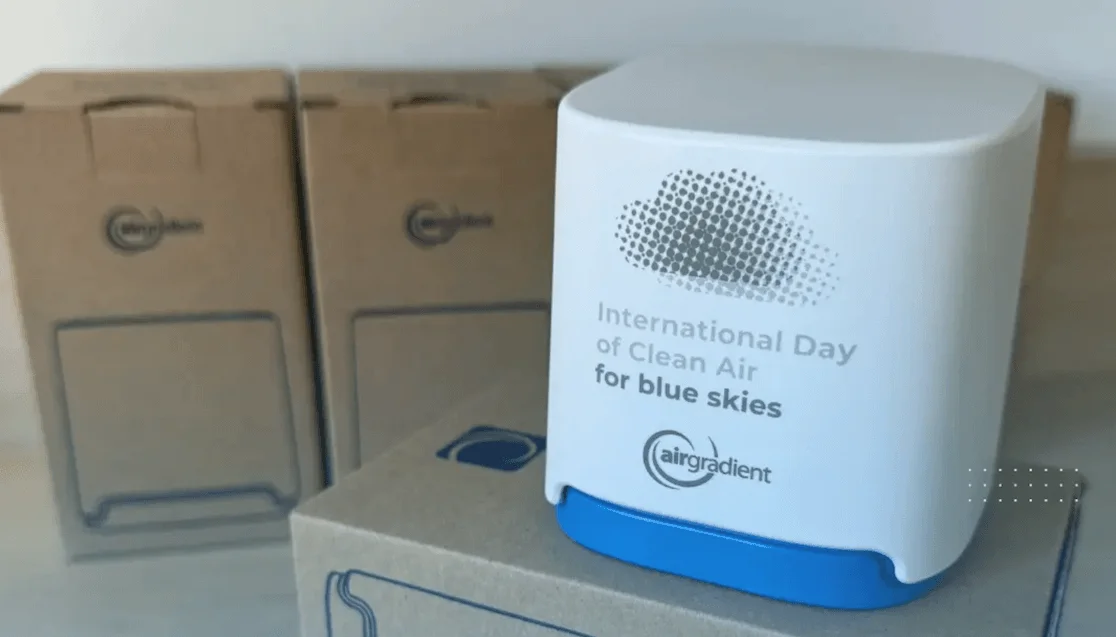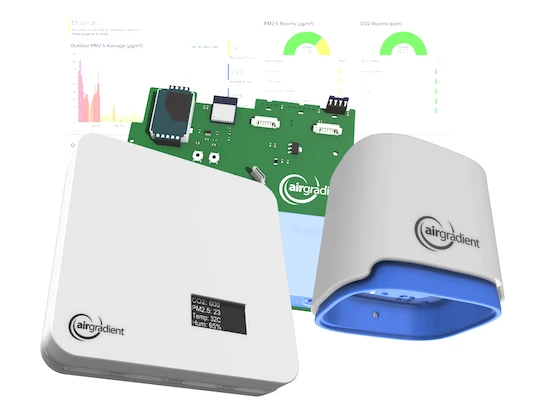AirGradient Open Source Air Quality Monitors
We design professional, accurate and long-lasting air quality monitors that are open-source and open-hardware so that you have full control on how you want to use the monitor.
Learn Moreby Yohana Angeline on October 2, 2024
In celebration of the International Day of Clean Air for Blue Skies, we wanted to contribute to the mission of raising awareness about air quality. The United Nations General Assembly designed this day to strengthen international cooperation and reduce air pollution—values that align closely with our goal to positively impact air quality globally.
It all started with a quick meeting between Achim, Ethan, and me. We thought, “What can we do to support this day?”. After some back-and-forth ideas, we decided to hold a giveaway. We wanted to make it special, so Achim suggested creating a limited edition of our outdoor air quality monitors with the International Day of Clean Air for Blue Skies logo lasered onto it. We thought it was a great way to raise awareness and contribute to the day’s message.

Once the monitors were ready, we announced the giveaway. We invited people to participate by sharing their ideas on how they would use the monitors to make a positive impact in their communities. To gather these submissions, we created a form where participants could detail their plans for improving local air quality.
At first, we didn’t know what to expect. This was only our second giveaway, and we didn’t set specific expectations for how many people would join. But we were pleasantly surprised by the response! More than 35 people shared their plans—each filled with dedication to making a difference. It was truly heartwarming to see so many people passionate about air quality and their communities.
With such thoughtful entries, the next step became challenging—narrowing it down to five finalists. We carefully reviewed each submission, and it wasn’t easy to choose. Many of the stories were impactful, and we wished we could give a monitor to everyone. But as much as we wanted, we had to make difficult decisions. After much consideration, we chose the top five candidates.
From there, we turned to the AirGradient team and invited everyone to vote on the final two winners. After a day of thoughtful input from the whole team, we had our two lucky winners, whom you may have already seen in our recent posts and newsletter.
This giveaway was a special experience for us. It was created quickly—probably in less than a week—but it turned out to be much more meaningful than we had anticipated. By giving away these monitors, we’re not only supporting the winners but also enabling them to create a ripple effect and positive impact in their communities. It has been amazing to see the AirGradient community share our vision of making the world a better place, one small step at a time. Nearly every submission mentioned using the monitors to share air quality data with others, raising awareness about the air we breathe.
So where do we go from here?
On the one hand, it’s great to see so many positive entries, but on the other, it’s tough knowing that only two people can win. We don’t want to disappoint our community, which is why we’re planning to expand! We’re looking forward to doing more giveaways in the future, especially for those who don’t have access to our monitors. We are also working on additional ways to give back to the community. So stay tuned for future announcements, and thank you for being part of this journey with us!
Here’s How Our Winners Plan to Use Our Air Monitor to Drive Change
Okwong, Nigeria
I will advocate for clean air in the Makoko community in Lagos, Nigeria by using an Air Gradient air quality monitor to gather essential data. I will place the monitor in key locations at intervals around the community to get accurate, real-time readings on pollutants like PM2.5 and PM10. This will help us understand the pollution levels and identify the most affected areas. I will analyze the data to pinpoint pollution hotspots and figure out the main sources of poor air quality. With these insights, I will create clear, engaging reports and maps that show how pollution impacts our health.
I will share these findings through community meetings, social media, and local media to raise awareness about the air quality issues in Makoko. By working with local leaders, environmental groups, and health organizations, I will push for targeted actions, such as better waste management, stricter emission controls, and public education campaigns. I will also continuously monitor air quality to track improvements and keep the community and stakeholders involved in our efforts for cleaner air. This approach ensures that our advocacy is based on solid data and effectively drives meaningful change.
Mariano, Argentina
As a professor and researcher in renewable energy and environmental technologies, I would use the AirGradient monitor to gather real-time data on air quality in different areas of my community, particularly urban environments, and educational institutions. I plan to integrate the data into my ongoing work, where we study how air pollution affects everyday activities and public health. I would use the monitor to raise awareness about the impact of emissions from transportation, industry, and residential areas. By sharing the data with local stakeholders, including schools and municipal authorities, we can promote informed decisions on actions to improve air quality, such as implementing greener transportation solutions and increasing green spaces.
Additionally, I would involve my students in this initiative, using the data for hands-on learning projects that encourage them to become advocates for cleaner air in their communities. I aim to foster a greater sense of responsibility for air quality and inspire collective action toward cleaner skies.
And here is a summary of all respondents (Thanks to Google Gemini for summarizing them):
It’s clear from these responses that people are eager to use air quality data to make a difference in their communities! Here’s a breakdown of the key themes and some standout examples:
Health Concerns: Many people are motivated by personal health issues or a desire to protect vulnerable groups like children and the elderly.
Community Action and Awareness: People want to use data to inform and mobilize their communities.
Advocacy and Policy Change: Many see data as a powerful tool to influence policy decisions.
Research and Education: Air quality data is valuable for research and educational purposes.
Filling Data Gaps: People want to monitor air quality in areas where data is currently lacking.
Curious about upcoming webinars, company updates, and the latest air quality trends? Sign up for our weekly newsletter and get the inside scoop delivered straight to your inbox.
Join our Newsletter
We design professional, accurate and long-lasting air quality monitors that are open-source and open-hardware so that you have full control on how you want to use the monitor.
Learn More